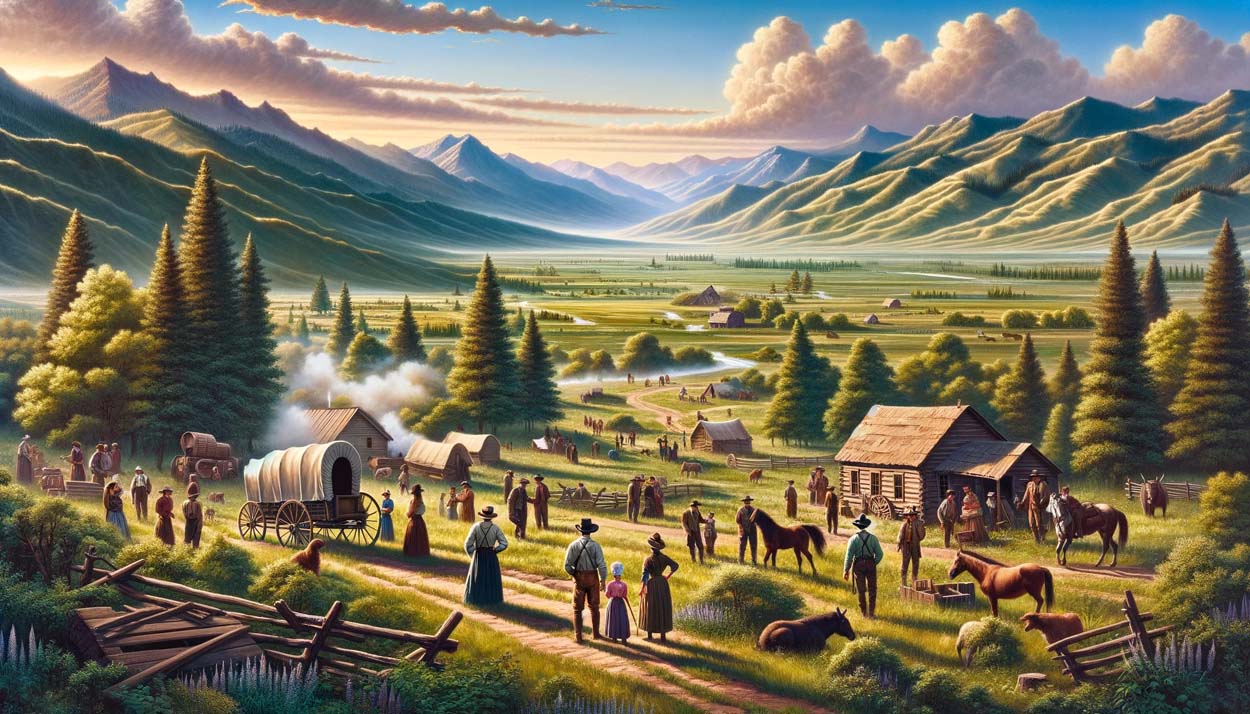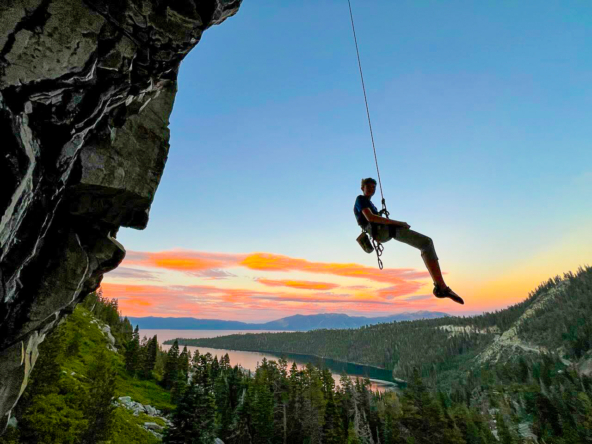Exploring the Rich History of Carson Valley, Nevada
Carson Valley, Nevada, stands as a region rich in history and brimming with natural beauty. Its story unfolds through time, highlighting the footprints of indigenous peoples, explorers, settlers, and modern residents. This blog post journeys through the history of Carson Valley, charting its transformation from a pristine wilderness to a flourishing community.
The history of this valley is more than a sequence of dates and events; it’s a narrative of human tenacity and the magnificence of nature. The landscape itself tells a story, from the meandering Carson River, which gives life to the valley, to the towering Sierra Nevada, which has overseen the area’s evolution for millennia. The saga of Carson Valley is a vivid reflection of survival, growth, and change, encapsulating the essence of the American West.
In this exploration, we encounter the valley’s initial inhabitants, whose existence and culture were deeply intertwined with the environment. Their legacy forms the bedrock of the valley’s history, paving the way for the influx of explorers and settlers who would later transform the region.
The development of Carson Valley mirrors the fluctuating fortunes of Nevada, from the feverish silver rush era to its current status as a serene symbol of rural America. Each period has left an indelible imprint, contributing to the diverse tapestry that defines the valley today. Scattered across the region are significant landmarks, both natural and constructed, that stand as testaments to its historical journey.
This introduction serves as a gateway to the rich heritage of Carson Valley. In the following sections, we will navigate through the eras, from the pre-settlement days to modern times, revealing the events, personalities, and landmarks that have crafted the distinctive character of this part of Nevada.
Pre-Settlement Era
The Ancient Roots of Carson Valley
Before it became known to settlers and travelers, Carson Valley was a land of untouched beauty and ecological diversity, home to indigenous tribes who lived in harmony with the natural world. The Washoe people, in particular, were the valley’s earliest known inhabitants, with a history in the region dating back thousands of years.
- Indigenous Heritage: The Washoe tribe’s presence in Carson Valley is a testament to their deep connection with the land. They led a nomadic lifestyle, skillfully navigating the changing seasons and the diverse landscapes that ranged from the valley floor to the mountain peaks. Their lives were intricately tied to the cycles of nature, relying on the land for sustenance, shelter, and spiritual fulfillment.
- Natural Abundance: The valley, with its fertile land and abundant water sources, provided a rich environment for the Washoe people to hunt, fish, and gather. The Carson River, a vital lifeline, supported diverse ecosystems and served as a crucial resource for wildlife and plant life, which in turn supported the indigenous population’s needs.
- Cultural Significance: The natural features of Carson Valley held spiritual and cultural significance for the Washoe tribe. Places like Lake Tahoe and the surrounding mountains were not just resources but sacred sites, integral to their cultural narratives and practices. The tribe’s deep respect for the environment is evident in their stewardship of the land, which they maintained with sustainable practices and a philosophy of coexistence.
- Legacy and Change: The arrival of European explorers and settlers marked the beginning of significant changes for the Washoe and the landscape of Carson Valley. However, the legacy of the Washoe people remains embedded in the region, with their history, traditions, and respect for the natural world continuing to influence the valley’s cultural tapestry.
The pre-settlement era of Carson Valley paints a picture of a land rich in natural resources and cultural depth, shaped by the people who first called it home. Their legacy is a foundational aspect of the valley’s history, setting the stage for the transformations that would follow with the advent of new settlers.
Founding and Early Settlement
The Dawn of Settlement in Carson Valley
The foundation of Carson Valley as a recognized settlement began in the mid-19th century, a period marked by the influx of pioneers and explorers drawn by the allure of opportunity and new beginnings. This era laid the groundwork for the valley’s transformation from a native land to a burgeoning community.
- Pioneer Arrival: The first wave of European settlers arrived in the 1850s, attracted by the potential for agriculture and the promise of wealth from the nearby Comstock Lode silver discovery. These early settlers, predominantly from the eastern United States and Europe, were enticed by the valley’s fertile land and strategic location as a waypoint on the California Trail.
- Agricultural Beginnings: The settlers quickly recognized the agricultural potential of the valley, with its ample water supply and rich soil. They established farms and ranches, cultivating crops and raising livestock, which became the backbone of the local economy. This agricultural endeavor marked the beginning of a settled lifestyle, contrasting with the nomadic existence of the indigenous inhabitants.
- Community Formation: Alongside farming and ranching, settlers began to establish the infrastructure necessary for a growing community. The establishment of towns like Genoa, Nevada’s first settlement, provided focal points for trade, governance, and social interaction. These early towns were crucial in shaping the identity and culture of the evolving community.
- Interactions with Native Populations: The arrival of settlers led to significant interactions with the native Washoe people, often marked by conflict and cooperation. These interactions resulted in a complex relationship that influenced the social and economic development of the valley.
The early settlement period of Carson Valley was a time of rapid change and development, setting the stage for the area’s future growth. This foundational era, characterized by pioneering spirit and agricultural innovation, was instrumental in transitioning the valley from a native landscape into a thriving agricultural and community hub.
Founding and Early Settlement
Establishing Carson Valley: A New Frontier
The settlement of Carson Valley began in earnest during the mid-19th century when the allure of opportunity and the promise of new beginnings drew pioneers to this fertile land. This era signified a crucial phase in the region’s transformation from a primarily indigenous territory to a burgeoning agricultural and trading center.
- Initial Explorations and Settlements: The valley’s strategic location along the California Trail made it a vital stopover for settlers heading west during the California Gold Rush. The first recorded non-indigenous settlers, John Reese and his party, established a trading post in 1851, laying the groundwork for future development.
- Agricultural Development: Recognizing the valley’s agricultural potential due to its rich soil and ample water supply, early settlers quickly established farms and ranches. These ventures proved successful, leading to the valley’s reputation as a fertile agricultural region. Crops like wheat, barley, and corn became staples, supporting both the local economy and the needs of passing travelers and miners.
- Town Formation and Growth: The establishment of permanent settlements, including Nevada’s first town, Genoa, in 1851, marked a significant milestone in the valley’s development. These towns became centers of social, economic, and political activity, facilitating further growth and stability in the region.
- Interaction with Native Populations: The influx of settlers impacted the indigenous Washoe people, leading to shifts in the region’s demographic and cultural landscape. Despite conflicts, there was also a degree of cooperation and exchange between the two groups, shaping the evolving community dynamics.
The early settlement of Carson Valley was a pivotal period of growth and establishment, characterized by agricultural prosperity and the formation of cohesive communities. This era laid the foundation for the valley’s future, transforming it into a key agricultural hub and a vital part of Nevada’s development.
Economic Development and Growth
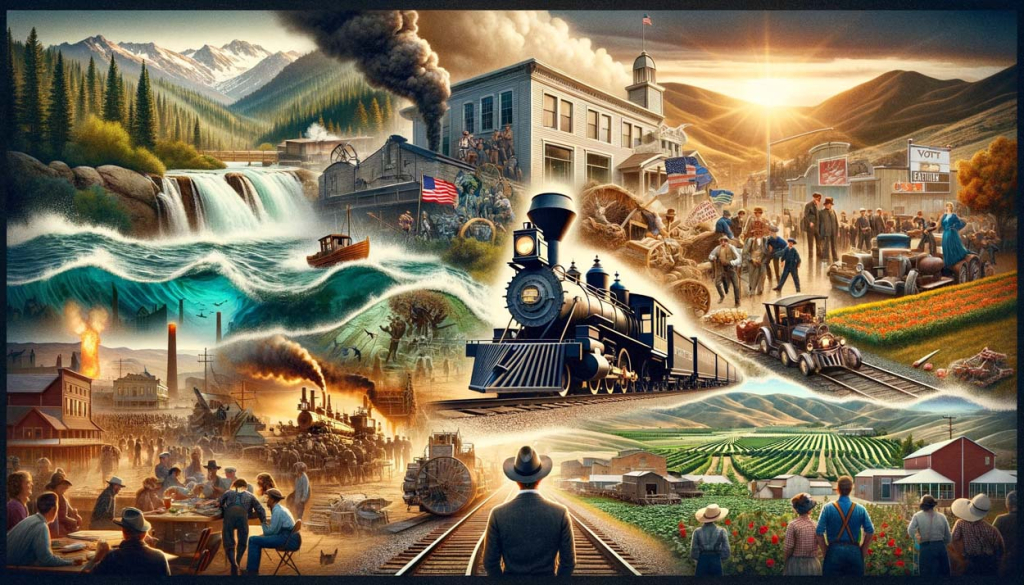
Economic Evolution in Carson Valley
As Carson Valley transitioned from early settlement to a flourishing community, its economic landscape underwent significant transformation. The valley’s economy, initially rooted in agriculture and ranching, diversified over time, reflecting broader regional and national trends.
- Agricultural Expansion: In the late 19th and early 20th centuries, Carson Valley’s economy was heavily reliant on agriculture, with vast tracts of land devoted to farming and livestock. The production of grains, fruits, and dairy products became economic staples, supporting local needs and contributing to regional trade.
- Mining and Industrial Influence: The discovery of precious metals in the nearby Sierra Nevada, particularly during the Comstock Lode silver boom, had a profound impact on the valley. Although mining was not as prevalent in the valley itself, its proximity to major mining centers like Virginia City brought economic spillovers, including a demand for agricultural products and lumber, and a boost in local trade and transportation.
- Commercial and Urban Development: As the region’s population grew, so did its commercial and urban centers. Towns like Minden and Gardnerville emerged as vital hubs, fostering a shift towards more diverse economic activities. Retail, service industries, and small manufacturing began to complement the agricultural economy.
- Tourism and Recreational Growth: In the 20th century, the valley’s picturesque landscapes and proximity to Lake Tahoe and other natural attractions spurred growth in tourism and recreation. This sector became increasingly important, with visitors drawn to the area’s natural beauty, outdoor activities, and heritage sites.
- Modern Economic Trends: Today, Carson Valley’s economy is a dynamic mix of agriculture, manufacturing, retail, and tourism. Technology and service sectors are growing, reflecting wider economic trends, while maintaining the region’s historical roots in farming and ranching.
Carson Valley’s economic development story is one of adaptability and growth, evolving from a primarily agrarian base to a diversified economy that balances traditional industries with modern opportunities, maintaining its historical essence while embracing the future.
Notable Historical Events
Pivotal Moments in Carson Valley’s Past
Carson Valley’s history is marked by several notable events that have shaped its development and character. These events, ranging from natural disasters to economic booms and busts, played a significant role in the evolution of the region.
- The Great Flood of 1862: One of the most significant natural disasters in the valley’s history was the great flood of 1862, which caused widespread destruction to the burgeoning settlements and agricultural lands. This event tested the resilience of the early settlers and led to changes in farming practices and community planning to mitigate future flood risks.
- Comstock Lode Silver Rush: Although primarily located in Virginia City, the silver rush of the mid-19th century significantly impacted Carson Valley. The valley served as a key agricultural supplier to the booming mining towns, leading to rapid economic growth and an influx of population, as well as infrastructure development in the area.
- The Arrival of the V&T Railroad: The completion of the Virginia and Truckee Railroad in the 1860s enhanced Carson Valley’s connectivity with the surrounding regions, facilitating trade and travel. This development was instrumental in integrating the valley’s economy with the larger Nevada and California markets.
- 20th Century Wars and Their Impact: The world wars of the 20th century brought changes to Carson Valley, with local men and women serving in the military and the home front adapting to wartime economies. These periods fostered a sense of unity and patriotism, impacting the community’s social fabric.
- Agricultural and Economic Shifts: The latter half of the 20th century saw shifts in agricultural practices, with a move towards more sustainable and specialized farming methods. The valley’s economy also diversified during this time, reducing its reliance on agriculture and expanding into services, tourism, and light manufacturing.
These pivotal moments in Carson Valley’s history highlight the region’s capacity for resilience and adaptation. Each event has left an indelible mark on the valley, influencing its trajectory and shaping the community’s identity.
Historical Landmarks and Sites
Exploring the Heritage of Carson Valley
Carson Valley is dotted with historical landmarks and sites that tell the story of its rich past. These locations are not only tourist attractions but also serve as a testament to the region’s diverse history, from its indigenous roots to its development into a thriving community.
- Genoa, Nevada’s First Settlement: Founded in 1851, Genoa is often considered Nevada’s first permanent settlement. With buildings like the Genoa Courthouse Museum and the famous Genoa Bar, the oldest continually operating bar in Nevada, Genoa offers a glimpse into the state’s early settler life and pioneer spirit.
- Mormon Station State Historic Park: This site commemorates the original trading post and fort established by John Reese and his party. The park includes a replica of the original 1851 trading post and offers educational exhibits about the early settlers and the history of the region.
- Dangberg Home Ranch Historic Park: This ranch is one of Nevada’s most significant historical estates, showcasing the life and times of one of the valley’s most influential families. The park’s guided tours provide insights into the agricultural, social, and economic aspects of life in the valley across different eras.
- Carson Valley Museum & Cultural Center: Housed in a beautifully restored 1916 high school building, this museum presents exhibits on the history of the Washoe people, the development of the valley, and the life of settlers and early residents.
These landmarks and sites offer a tangible connection to Carson Valley’s past, each with its own story and significance in the tapestry of the area’s history. They serve as a bridge between the past and present, allowing visitors and residents alike to step back in time and experience the valley’s historical journey.
Cultural Evolution and Diversity
The Tapestry of Culture in Carson Valley
Carson Valley’s cultural landscape has evolved significantly, shaped by various waves of migration and the interactions of different communities. This evolution reflects a rich tapestry of cultural diversity, traditions, and heritage that have contributed to the unique identity of the region.
- Indigenous Roots: The valley’s cultural foundation is deeply rooted in the traditions and practices of the Washoe tribe, the area’s original inhabitants. Their customs, art, and relationship with the land have left a lasting impact on the region’s cultural ethos.
- Settler Influence: The arrival of European settlers in the mid-19th century introduced new cultural dimensions, with agricultural practices, architectural styles, and community structures that reflected their origins. Towns like Genoa, with its historic buildings and sites, exemplify the blend of Native American and European influences.
- Migration Waves: Throughout its history, Carson Valley has seen various waves of migration, each bringing different cultural influences. These include the Basque shepherds in the 19th century, whose legacy is still celebrated through local cuisine and festivals, and more recent arrivals, who contribute to the cultural mosaic.
- Cultural Festivals and Events: The valley hosts numerous cultural events that celebrate its diverse heritage. Events like the Genoa Cowboy Festival, Basque Festival, and Candy Dance reflect the region’s multifaceted cultural history and attract visitors from far and wide.
- Artistic and Literary Contributions: The valley’s scenic beauty and cultural richness have inspired many artists and writers, contributing to a vibrant arts scene that includes galleries, music, and literary works.
Carson Valley’s cultural evolution is a dynamic process, continually enriched by the contributions of its diverse population. This cultural diversity not only adds to the region’s charm but also fosters a sense of community and belonging, making it a place where history and heritage are celebrated and preserved.
Modern Growth and Development with David Goodwin, EXP Realty
Carson Valley’s Evolution: Navigating the Modern Era with David Goodwin
Carson Valley has gracefully transitioned from its historical origins to a period of significant growth and modernization, blending tradition with progress. This evolution reflects the region’s ability to honor its past while adapting to future possibilities, a journey expertly navigated by David Goodwin of EXP Realty.
- Economic Diversification and Opportunities: Agriculture has long been the economic mainstay of Carson Valley, yet recent decades have seen a shift towards diversification. The valley now thrives with industries like aerospace, food processing, and renewable energy, broadening the economic base. David Goodwin, with his comprehensive understanding of the local market, is poised to assist those looking to participate in this vibrant economy, offering insights and opportunities in these expanding sectors.
- Population Growth and Sustainable Development: The allure of Carson Valley’s lifestyle, coupled with economic prospects and natural beauty, has spurred population growth and urban development. David Goodwin, through EXP Realty, plays a crucial role in managing this growth, ensuring that new residential and commercial projects enhance the community while preserving the valley’s character and resources.
- Enhanced Connectivity and Technological Integration: The advent of modern technology has elevated Carson Valley’s appeal, making it a prime location for remote work and digital enterprises. David Goodwin recognizes the potential of this connectivity, facilitating real estate solutions that cater to the needs of a tech-savvy populace and businesses aiming to tap into the valley’s dynamic market.
- Commitment to Sustainability: Underpinning the region’s development is a strong commitment to environmental stewardship. Initiatives focusing on natural habitat protection, water conservation, and renewable energy align with the community’s sustainable vision. David Goodwin supports these initiatives, offering properties and investment opportunities that reflect the community’s dedication to sustainable living.
In Carson Valley’s journey into the modern era, David Goodwin of EXP Realty stands as a guiding force, blending historical respect with modern dynamism. For those seeking to be part of this evolving landscape, David offers a gateway to a life that harmonizes heritage with contemporary living. To explore the possibilities in Carson Valley, visit David Goodwin’s contact page.
Notable Personalities from Carson Valley
Influential Figures Shaping Carson Valley’s Legacy
Carson Valley’s history is adorned with personalities who have played pivotal roles in shaping its character and legacy. These individuals, from diverse backgrounds and fields, have contributed to the valley’s development and left an indelible mark on its cultural and social fabric.

- Snowshoe Thompson: One of the most legendary figures, John “Snowshoe” Thompson, was a Norwegian immigrant who became a local hero in the mid-19th century. He earned his nickname by delivering mail across the treacherous Sierra Nevada mountains on skis, connecting Carson Valley with the outside world during harsh winters.
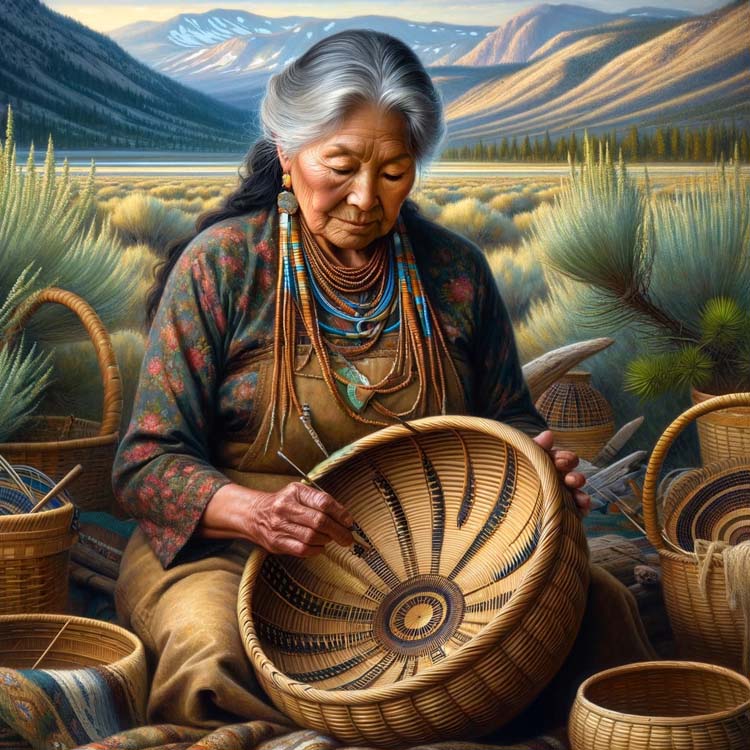
- Dat So La Lee: A renowned Washoe basket weaver, Dat So La Lee is celebrated for her exquisite and intricate basketry work, which has gained national recognition. Her artistry not only reflects the rich cultural heritage of the Washoe people but also highlights Carson Valley’s role in preserving Native American crafts.
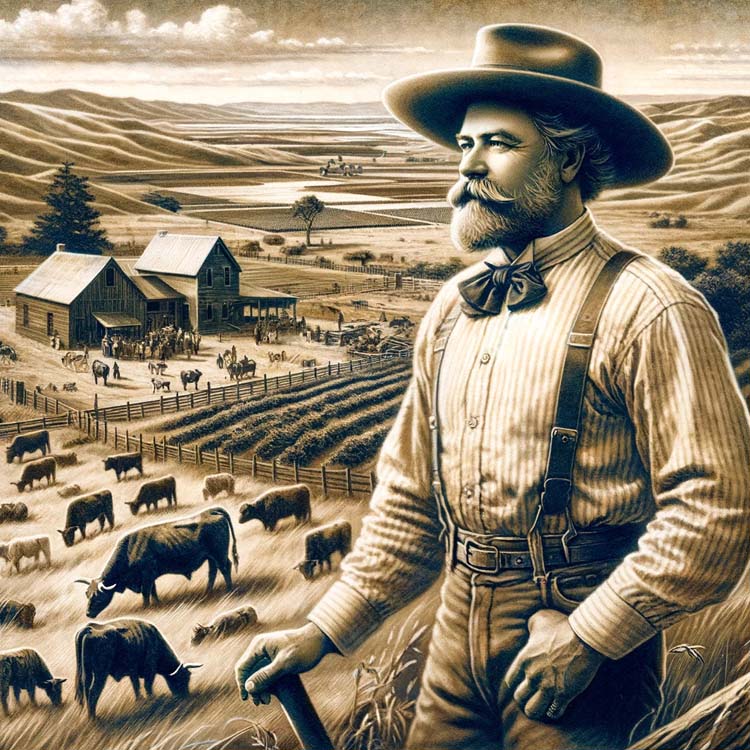
- H.F. Dangberg: As a founding father of the valley, Heinrich Friedrich Dangberg was a German immigrant who established the H.F. Dangberg Land and Livestock Co., laying the groundwork for agricultural development in the area. His legacy includes the Dangberg Home Ranch, which is now a key historical site.

- Grace Dangberg: Grace Dangberg, a descendant of H.F. Dangberg, played a significant role in preserving the history and heritage of Carson Valley. Her efforts in historical preservation and her contributions to local museums have been vital in maintaining the region’s historical narrative for future generations.
These personalities, among others, have woven the rich tapestry of Carson Valley’s history. Their stories of innovation, artistry, entrepreneurship, and dedication contribute to the region’s distinctive identity and enduring spirit. Through their contributions, they have helped shape Carson Valley into the vibrant and dynamic community it is today, bridging its storied past with a promising future.
Strategic Location and Connectivity
Carson Valley: Crossroads of Nature and Progress
Carson Valley’s strategic location and connectivity have played pivotal roles in its history and development. Positioned at the crossroads of natural beauty and economic progress, the valley has leveraged its geographical advantages to foster growth and accessibility.
- Geographical Advantage: Nestled between the Sierra Nevada and the Great Basin, Carson Valley benefits from its proximity to major natural attractions like Lake Tahoe and Yosemite National Park, as well as its accessibility to urban centers like Reno and Carson City. This unique positioning has made it an attractive location for both residents and businesses, offering a blend of rural tranquility and urban convenience.
- Transportation Infrastructure: The development of transportation networks, including major highways and nearby airports, has facilitated regional connectivity and economic growth. U.S. Route 395, running through the valley, provides direct access to key destinations and markets, while the proximity to Reno-Tahoe International Airport supports both domestic and international travel.
- Economic Gateway: The valley’s location has made it a gateway for trade and commerce in the region. Its accessibility to major transportation routes has attracted a variety of businesses, from logistics and manufacturing to retail and services, benefiting from the ease of distribution and access to a broad customer base.
- Community and Lifestyle: The strategic location also enhances the quality of life for residents, offering easy access to employment opportunities, educational institutions, healthcare facilities, and recreational activities. The balance of natural beauty and modern amenities attracts a diverse population, from families to retirees and professionals, who value both the serene environment and the economic vitality of the area.
Carson Valley’s strategic location and connectivity continue to be integral to its identity and appeal, merging the tranquility of a rural landscape with the dynamic opportunities of a connected, modern community. This synergy not only drives the valley’s ongoing development but also preserves its heritage and natural beauty for future generations.
FAQ Section
What is the history of Carson Valley, Nevada?
Carson Valley has a rich history that dates back to the indigenous Washoe tribe, followed by the arrival of European settlers in the mid-19th century. It developed through the agricultural, mining, and later, the tourism and service industries, evolving into a vibrant community that balances modern living with historical preservation.
Are there any notable historical landmarks in Carson Valley?
Yes, Carson Valley is home to several historical landmarks, including Genoa, Nevada’s first permanent settlement, the Mormon Station State Historic Park, the Dangberg Home Ranch Historic Park, and the Carson Valley Museum & Cultural Center. These sites offer insights into the region’s past and its development.
What are the main economic drivers in Carson Valley today?
Today, Carson Valley’s economy is diverse, with major contributions from agriculture, manufacturing, technology, and tourism. The region has seen growth in various sectors, providing a stable economic environment and numerous employment opportunities.
How has Carson Valley maintained its natural beauty and environment?
Carson Valley has placed a strong emphasis on sustainability and environmental conservation. Efforts include protecting natural habitats, promoting water conservation, and supporting renewable energy initiatives, ensuring that the valley remains a beautiful and healthy place to live.
How can I learn more about real estate opportunities in Carson Valley?
For those interested in real estate opportunities in Carson Valley, contacting a knowledgeable local realtor like David Goodwin of EXP Realty is a great start. Visit David Goodwin’s contact page for more information on available listings and to gain insights into the local market.

